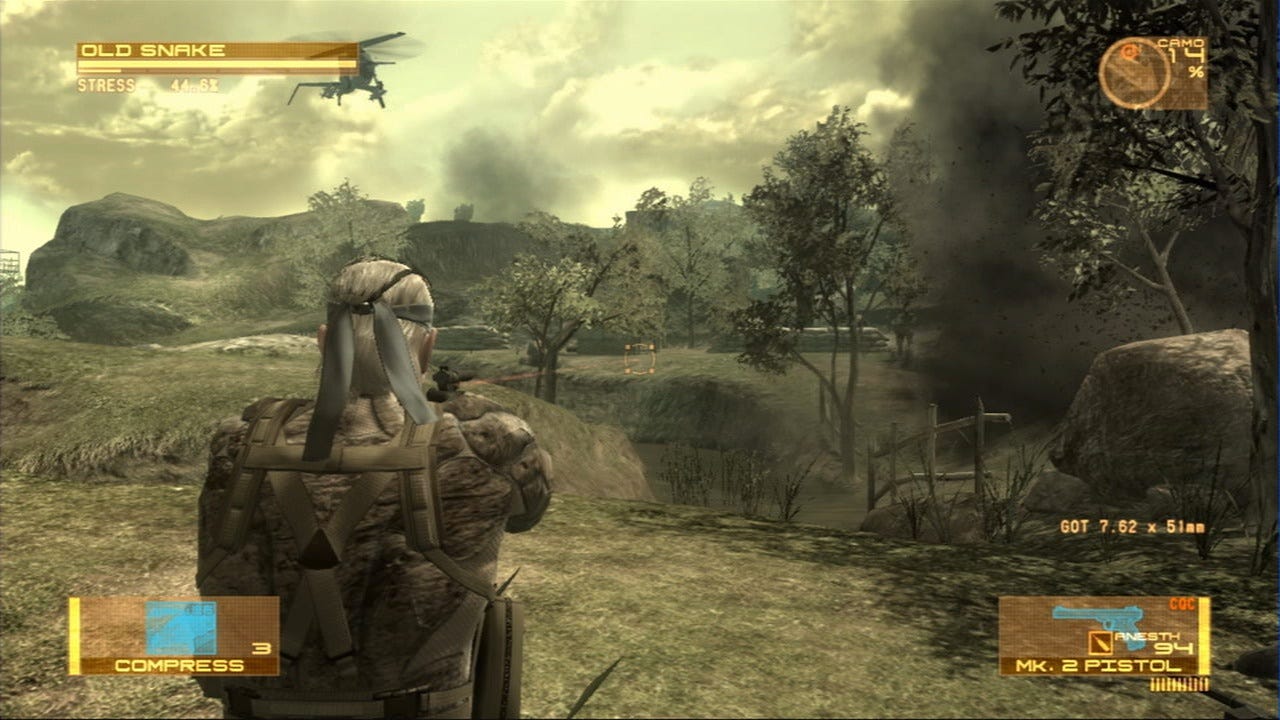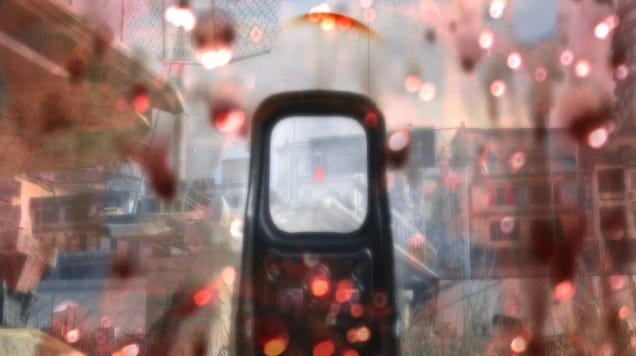People often compare games to movies but I like to compare games to food. I find programming similar to cooking for example - I do mise en place then bang through the typing quickly.
One strong similarity between the food and game industries is how fad-driven they are. Molecular gastronomy was all the rage for a while - molecular gastronomy is when you order steak and potatoes and get frozen steak chalk with potato foam. “Deconstructed” food was a trend that posed the question “what if you only did the prep?”
Plating is mostly aesthetic so it’s extremely faddish. You can serve a scoop of ice cream but if you’re fancy you can quenelle or rocher instead. Serving food over a smear was popular for a bit, as were spots and drizzles. There’s not much functional difference between these so they change periodically for the sake of change.
Which brings us to We Want Plates. We Want Plates is a twitter account / reddit sub / vital social movement that says “plating does have some functional requirement so please give me a vessel that at least properly holds the food.”

This sort of plating is increasingly common even though it fails at the most basic level. It’s not even novel or interesting anymore - it’s just annoying.
Today I’m looking at video game features whose popularity outstrips their worth - overused features, or once-ubiquitous features now sheepishly binned. Games don’t have many functional requirements so I can’t say many of these are objectively bad - but often their inclusion is a net negative.
It’s not too interesting to just list bad fads; I’ll also discuss the difference between justification and rationalize, and the kind of thinking that leads to faddish design.
Post-Processing in the 360 Era
Low quality bloom was an epidemic in 360 era. (This page has many good examples) Bloom can be hard to get right technically, but it seemed like some games weren’t even trying, instead leaning into glowing bald heads and white shirts.
There’s not much to say about the “piss filter” beyond “yuck.” In theory it makes for “gritty realism” but real life isn’t uniformly brown so I’m not buying it. Sometimes new effects are overdone to show off - better too noticeable than not noticeable enough. The first normal maps were high amplitude on shiny surfaces - normal maps looked cool when they were new so that’s understandable. But turning the screen brown was never impressive.
The red jam effect may be the worst of this era’s full screen effects. We determined that players need more visual cues when they’re taking damage or low on health - fair enough. But somehow that birthed the strawberry jelly effect.
Red jam on your screen is supposedly diegetic and realistic: if you get shot in real life the consequence is a glob of red jam gets smeared on the giant windshield in front of your face….? Much of the time this effect didn’t attempt to be a “blood in your eyes” effect or even a “blood on the camera lens” effect. Instead it was jam on a windshield.
Something I’ll keep coming back to is at the time developers rationalized these effects. But that we don’t see them much today reveals that these were rationalizations, not justifications.
In hindsight these effects look ugly and have aged poorly. The Last Remnant on PC has nice models and textures but the post effects look awful. The same is true of the remastered Kingdoms of Amalur: Reckoning - it looks nice until the presence of bad bloom, most noticeably on VFX.
Turret Sequences
I suppose the appeal of turret sequences is they provide a change of pace. But these sequences are most common in first and third-person shooters, and are often just worse versions of the game you’re already playing.
In Resident Evil 5 or Dead Space you can switch weapons, use melee attacks…move. Then you get to a turret sequence and it’s the same game but with one stationary weapon.
These sequences can work. The turrets in Monster Hunter are fun in small doses, since the game is primarily melee and the ballista and machine guns usually appear in set-piece battles. But it’s rare for them to work - more often than not they’re low points.
Not many game designers will admit “truth be told we put turret sequences in our game because it was the fashion at the time.” They may not consciously recognize that as their prime motivation. Instead they’ll say “turret sequences provide a palate cleanser.”
I consider that a rationalization rather than an explanation because much of the time it’s simply not true.
Slow Walking
Forced slow-walk sequences are something that’s just become A Thing Games Do.
"If every game is doing this there must be a reason” is seductive thinking. And sometimes it’s correct - if every game is doing something you don’t understand you may be missing something. But sometimes there’s nothing to miss.
NFL teams used to always punt on 4th down. Regardless of the score, the time remaining, or the yardage required for a first down - they would simply always punt.
A strictly rational actor would go for it on 4th down when appropriate. But while a coach could be fired for failing a 4th down attempt they would never be fired for punting, especially when every other coach in the league would also punt in that situation. So always punting was, for a long time, the accepted always-correct thing to do.
If every coach always punts on 4th down how could it be wrong? If every high-budget game has a slow-walking sequence clearly that’s correct…right?
It’s easy to say “question everything” but if you’re stopping to question every aspect of making a video game it’s going to take an extra 10 years. But we could probably afford to question more than we do, especially when it comes to design trends.
Questioning the win conditions of fighting games is how you get Smash Brothers. When Dark Souls released many complained that the attack buttons were on the shoulders - now I often hear people complain when other games use face buttons for attacks. In their minds what was considered “good design” is now “bad design” and vice-versa - the dogma has swapped. And those were well-liked features, not features like forced walk-and-talk or trite hacking minigames.
The slow-walking in No More Heroes, during which you listen to increasingly elaborate and unhinged phone calls coming from the Wii Remote speaker, is fun! But the majority of time I play a game with a slow-walking section my thought is simply “please just let me play the video game.” Walk and talk segments often seem to only exist because they’re standard practice - like punting on 4th down.
Smart people are good at convincing themselves of silly things. I think some game developers are good at disguising “other games are doing it” as more sophisticated reasoning.
Features of successful games have strong gravitational pull. If you’re making an open world game you probably want to add climbing and a glider, and while you can rationalize that the root motivation is likely “BOTW did it.”
Cover-based Shooting
There was a time when any shooter without a formal cover system got dinged in reviews. It wasn’t enough to have a natural cover system - if you hide behind a metal wall you’re safe, if you hide behind a wooden door you take some damage. No - a game had to have a “stick to cover” button with discrete protection rules, some mix of lean and blind fire mechanics, etc.
We don’t see a lot of that these days, for what I think is a simple reason: most of those games weren’t very fun.
Not only was cover shooting often not very fun, but in cases like Quantum Break it derailed the game. As I wrote once before:
One of the main complaints about Quantum Break was that it was a standard third person cover game with weak TPS mechanics that overshadowed the more unique gameplay elements . The rebuttal to that was “you’re playing it wrong” — you aren’t supposed to hide behind cover, you’re supposed to run and gun while using your powers. But then why does the game have familiar chest-high walls, a formal cover system and regenerating health? The level and system designers sure put a lot of work into things you’re supposed to ignore, things that indicate "stop and pop" rather than "run and gun" gameplay.
They made a game premised on using cool run-and-gun powers then saddled the game with “stop and pop” mechanics and level design.
Regenerating Health and 30 Seconds of Fun
Something that happens too often in game design is a game does something neat, it becomes a GDC presentation, that morphs into a memefied context-free distillation, then other developers repeat a warped version without understanding the original intent.
Halo’s “30 Seconds of Fun” is a prime example.
“30 Seconds of Fun” is, I believe, largely responsible for popularizing the pervasive “core gameplay loop1” talk we get today, and the idea that if your game is fun for 30 seconds you can loop those 30 seconds ad infinitum to create a hit game.
That’s not what “30 Seconds of Fun” was supposed to mean.
"All of which would be fine," he continues, "but the worst part is, everyone uses it to mean exactly the opposite of what I meant when I said it! They use it to say you only need 30 seconds of fun, and if you repeat something that is fun for 30 seconds over and over you have a game like Halo. There was a whole second half of the quote that got cut out of the Vidoc [video documentary] where I talked about taking that 30 seconds of fun and playing it in different environments, with different weapons, different vehicles, against different enemies, against different combinations of enemies, sometimes against enemies that are fighting each other. No 30 second stretch of Halo is ever repeated; the missions are constantly changing the context on you."
Constantly changing context is a hallmark of some of the best games. Resident Evil 4 and God of War (PS2), for example, have a huge variety of combat setups while rarely straying into one-off gimmicks or alternate mechanics. But “30 Seconds of Fun” has come to mean “endlessly repeat the same 30 seconds”, not “use the same great mechanics in widely-varying scenarios.”
Regenerating health is a key component of “30 seconds of fun” because it breaks gameplay into discontinuous 30-second blocks. You do 30 seconds of shooting, you hide behind a wall as your health regenerates, then you do another 30 seconds of shooting.
I have no complaints with the regenerating shields in Halo - it’s a scifi game so regenerating shields fit. In theory it opens up gameplay complexity - maybe you have a weapon that’s strong against shields but weak against health. But non-Halo games adopting this approach have been a very mixed bag.
An advertised strength of regenerating health is that it serves as a sort of save scumming, atomizing difficult segments of a game into discrete parts. In a game where you can’t heal between encounters the difficulty is additive- the more enemies you encounter the more you’re subject to attrition. If your health regenerates between encounters there’s no attrition, and the difficulty is more of a max function: if you can beat the hardest encounter you can beat them all. Is that what we want? The downsides of this approach are obvious.
The Getaway is often considered the game that popularized regenerating health. The Getaway was a game with two main gameplay modes - very fun open-world GTA-style driving sections and awful on-foot combat sections.
The on-foot sections in The Getaway have exactly the problem you’d expect: you can recover health between encounters, which means the game is trivially easy unless the encounters are very difficult - which they are. So the game is both too easy and too hard. In old beat-em-ups like Teenage Mutant Ninja Turtles you could cheese the game by barely inching forward, making enemies spawn in one at a time rather than in groups. That’s how you play The Getaway - you inch forward, fight an enemy, rest against a wall to heal up, repeat. It’s 30 seconds of tedium on loop.
When Doom 2016 released many were impressed that the game used glory kills to refill health rather than regenerating it. Glory kills aren’t health packs exactly, but they’re conditional health packs with different theming. Game industry institutional memory is so short, and we’re so fad-driven, that sometimes we forget about mechanics that work, or confuse “old” with “dated.”
That’s not to say the regenerating health is a fad that should die, but I suspect many games would be made stronger by ditching it.
The Jell-O Salads of Gaming
It’s not hard to look back and identify bad fads. But as game developers we should strive to identify valueless fads in the moment.
I don’t think Chicken Kiev or cheese fondue are popular these days but they’re fine dishes. Then there’s the Jello-O salad - a food that was never ever good. I wouldn’t say that regenerating health is a Jell-O Salad - regenerating health can be fine. But the “piss filter” is pretty close to Jell-O Salad territory. Most turret sequences are a serving of Jell-O Salad.
“RPG-style” colored loot in non-RPGs, where “Rare Ruby Batgloves” give you “a 25% chance to do 10% extra damage every third hit against Bane-type enemies” are Jell-O Salad. (I’m playing Stranger of Paradise: Final Fantasy Origin and on one level I got 30 of what are basically the same gloves) So are many skill tree implementations that space out meaningful rewards with imperceptible stat adjustments. I don’t like a lot of MTX implementations but I understand why they exist- they may not make for better games but they can make more money. But complex currency systems in games without MTX are usually Jell-O Salad.
Which brings us the modern Jell-O Salad that irks me the most.
We Want to Not Squeeze Through Cracks
That’s right - I wrote this piece to complain about “squeeze holes.”
I have two main objections to “squeeze holes.”
They rarely serve a useful purpose (that isn’t equally served by something better)
They lend the appearance of low quality
Second one first -Square-Enix tweeted out a video of Final Fantasy 162 that features a squeeze hole and this is the first reply I see:
The picture topping this section is from the first Unreal Engine 5 demo. It too features a squeeze hole.
Players associate squeeze holes with tech limitations - our understanding is that they’re fancy loading screens. When you add a squeeze hole to your game you’re adding a loading screen, and the Unreal Engine 5 demo is supposed to demonstrate the elimination of loading via the SSD and Nanite.
This a functional failure of the demo, not a subjective or aesthetic failure. The inclusion of the squeeze hole makes the demo less successful an advertisement for Unreal Engine 5, because it highlights an engine limitation. (That doesn’t actually exist)
There are rationalizations for squeeze holes but they read like rationalizations.
“The are less gamey and more realistic.” You could live for 1000 years and if you’re not into caving never come across a real life squeeze hole. Audio logs and blood-drawn graffiti are gamey, despite those too being “realistic.” Anything becomes “gamey” when it becomes a common gaming affectation.
“They imply one-way traversal, like a door that closes behind you” is another I’ve seen a lot. This one just doesn’t make sense: nothing about a narrow passageway implies it’s one-way.
“They can be used as gates.” So can gates and doors, magical barriers and a million other things. “They can be used to break up areas visually, and make for dramatic reveals” - sure but so can passageways, fog doors, etc. All of these are “to a man with a hammer everything looks like a nail” - to a team used to squeeze holes everything looks like a job for a squeeze hole.
These rationalization are flimsy, and they don’t apply to the Unreal Engine 5 demo since that’s not a game. There are no combat arenas to gate. There’s no need for one-way passages in a video.
You can convince yourself that squeeze holes make sense, but if they weren’t already in our lexicon as a way to mask loading I don’t think many would consider them the best solution to non-loading scenarios.
Why did the demo include a squeeze hole?
Epic wanted to demonstrate that Unreal Engine 5 could be used for next-gen AAA games, and those games have cracks you shimmy through, so their demo has them too. Fifteen years ago the demo might have had a turret sequence for the same reason.
Epic had to clarify that the crack traversal in their demo wasn’t a technical deficiency. God of War Ragnarok developers had to similarly clarify.
Butter served on a rock is goofy but functional; syrup spilling off of a board and onto your lap isn’t functional. Squeeze holes are like the worst “We Want Plates” offenders. I may not like turret sequences but maybe you do - taste is subjective. But adding the appearance of a loading screen and technical deficiency to a game is self-sabotage.
This is outside the scope of this blog but I don’t find “core gameplay loop” a useful term. Very often it’s used to refer entirely to structure, not gameplay. Games are naturally repetitive due to production realities - nobody is going to create hundreds of unique mechanic and enemies. Thinking in “core gameplay loop” terms encourages developers to make their games more repetitive, when in most cases they’d be better off striving to avoid noticeable repetition.
After playing the demo I assume the squeeze holes and other common “cinematic” traversal bits are done the way they are to keep players from using them during combat, which would make enemy AI and animation more complicated. But these traversal sections add little to the game.












Really enjoyed reading this piece, especially the section about 30 seconds of fun. I feel like that's my big problem with most action games and shooters today - they're designed for you to repeat simple combat loops where longterm engagement comes from progression systems, rather than building robust and flexible mechanics which can thrive through a variety of recontextualisations. The prevalence of open worlds etc only encourages these design philosophies.
Shame you had to demean the fine art of hole squeezing, though.